|
FAQs on Hogfish Wrasses, Genera Bodianus,
Lachnolaimus Identification
Related Articles: Hogfish Wrasses,
Lachnolaimus maximus,
Related FAQs: Hogfish
1, Hogfish 2, Lachnolaimus maximus,
Hogfish Behavior,
Hogfish Compatibility, Hogfish Selection, Hogfish Systems, Hogfish Feeding, Hogfish Disease, Hogfish Reproduction, Wrasses, Wrasse Selection, Wrasse Behavior, Wrasse Compatibility, Wrasse Feeding, Wrasse Diseases,
|
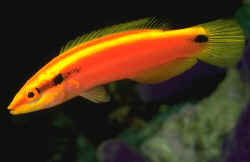
|
|
Yellow Wrasse with Black spots, ID, trtmt.
6/19/12
Hi crew,
<Joan>
Let me first mention how much I appreciate your help and responses. So
far, you've saved a beautiful Birdsnest coral for me and calmed my fears
regarding a Firefish concern. You're wonderful!!
<Ahh!>
I have a new concern that I've searched info on all weekend and just
need a bit of support to be sure my decision making is valid or should
be altered.
I purchased a yellow wrasse 10 days ago. I don't believe he is a true
yellow wrasse but would be interested in your opinion on the species.
Pictures are attached. He is yellow with pink/orange shaded sides and
light orange spots down the side. He has a black dot on the tail, behind
the eye, and 3 on the dorsal fin. What species of wrasse is this?
<Bodianus bimaculatus;
http://www.wetwebmedia.com/marine/fishes/wrasses/bodianus/index.htm
Background info: He was at the LFS for 3 weeks prior to purchase in
copper solution. His dorsal fin was missing sections with a beat-up
look. I fresh dipped him with RO water
<Freshwater itself is fine... RO needs to be aerated... as it has no
gas/oxygen>
and Methylene blue upon arrival for 2 1/2 minutes.
He was wild during the process even managing to jump out. I didn't keep
him in the dip any longer than this due to his behavior. He then went
into the QT tank. Seven days into the QT process, he suddenly developed
small black spots/smudges on his back on both sides of his dorsal fin.
<Not a problem>
The pictures are blurry due to his constant movement, but I hope you can
glimpse the areas of concern. I'm just not sure if we are looking at
black ick, worms, or a bacterial infection. QT water is zero for
ammonia, nitrites, and phosphorus.
So far, I've added PraziPro to the water. We are now on Day 4 of the
medication and no changes in the spots/smudges. I thought my next step
would be too start hyposalinity for 4 weeks and possible add an
antibiotic during this process.
<Mmm, I wouldn't. Just isolation should suffice>
During this entire time, he acts totally normal.
Eating well, swimming around, curious and doing fine. What are
your thoughts on the spots? The treatment plan?
<Not a worry; no treatment>
As always, your support is tremendous.
Thank you,
Joan
<Welcome. Bob Fenner>
|
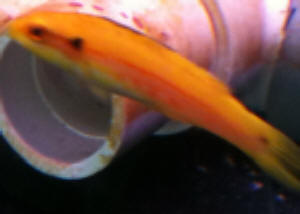 |
|
Re: Yellow Wrasse with Black spots 6/19/12
Bob,
<Joan>
Now I see why you said not to worry about the spots/smudges on his back!
This is the beginnings of his adult markings (2 brown strips on the
upper half of the body.) I just have a juvenile starting to develop. I
just knew this wasn't the fish aka "yellow wrasse"
<Halichoeres chrysus? No>
I thought I bought. But, now I'm even happier ~ he will be truly beautiful
and still a wonderful addition to my reef tank. I certainly won't worry
about any disease at this point.
<This smaller "Hog" is a fave... quite hardy, beautiful and intelligent>
Thanks again for calming my fears.
Joan
<Glad to assuage them. BobF>
|
|
Please help identify
4/30/12
I have been searching all over trying to identify this fish I found in the
Galapagos Islands, Ecuador.
Can you help me?
<Wonderful picture of a Bodianus diplotaenia aka Mexican Hogfish--
http://www.fishbase.org/summary/Bodianus-diplotaenia.html >
Thank you,
<Quite welcome>
Diana
<Jordan>
|
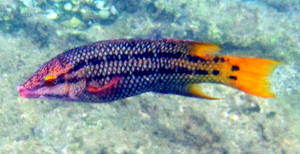
|
Re: Please help identify 4/3012 5/3/12
> Bob, could you take a look at the second half of the query concerning
photos.
> Thanks,
> Jordan
<<Sure>>
> Wow! Thanks...
> <Not a problem. I apologize for the slow response.>
> I originally thought it was a Wrasse. It looks so
> different than the other picture I took of a Mexican Hogfish (also in
> Galapagos). Should I assume that the one you identified for me was a
> juvenile female?
> <You are correct. Juveniles, sub-adults, females, and males are all
quite
> different in appearance. The newest picture is of a dominant male.
Another
> great photo.>
> Thanks again for your time,
> <Quite welcome>
> Diana
> BTW I am not familiar with your website - I just came across it when I
was
> trying to identify the fish. Do you collect pictures of fish from all
over
> or are they your personal collections? I have no personal copyright
> issues... do you want any of mine? You are welcome to them. I actually
> have some other much better photos and some unusual shots or species.
> <This would be an area to discuss with Bob. I've sent him a copy of
your query.>
> <Jordan>
<<Those on WWM are mostly efforts by me... w/ some like yours as write
ins. I suggest you consider becoming a collaborator on fishbase.org if
you have the time/interest, and have your images offered to the public
there. IF you have the leaning, I will gladly help you to write against
your image work and submit to the pulp and e-zines in the dive, travel
and petfish interests. Bob Fenner>
|
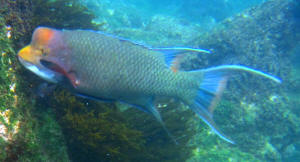 |
|
|
help. Hogfish ID, snails in FW sys., NNS
6/14/11
Dear Wet Web Media
Please help me to identify this fish (attached picture).
<... A Bodianus sp. See here:
http://wetwebmedia.com/marine/fishes/wrasses/bodianus/index.htm
Is too much snails a bad thing?
<Mmm, can be...>
I have a lot of small brown snails in my tropical aquarium. I
don't know where they came from, maybe from plants I bought
or something. But every week I see more and more.
Please help.
<... read here: http://wetwebmedia.com/FWSubWebIndex/fwsnails.htm
and the linked files above. Bob Fenner>
Thank you
Monique
|
|
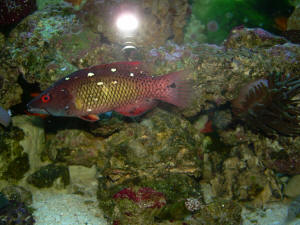
|
Monster Peppermint Hogfish, An error on LiveAquaria
4/16/10
Hi Crew,
<Tom>
Had you heard of a Peppermint Hogfish that reaches 1' 8", like
this one for sale on LiveAquaria?
http://liveaquaria.com/diversden/ItemDisplay.cfm?c=2733+3&ddid=86380
Tom
<Have heard of this recently described (Gomon 2006) species, but not
seen it. I think LiveAquaria's stated maximum size is an error...
This fish likely gets to less than four inches total length, 8.7 cm.
according to Fishbase.org:
http://www.fishbase.org/Summary/speciesSummary.php?ID=64240&genusname=Bodianus&speciesname=sepiacaudus
Bob Fenner>
|
Fish identification 8/9/09
Hello WWM crew!
<Pedro>
I purchased this fish but I can't remember the name now. I
was hoping you could ID it for me.
<... see here:
http://wetwebmedia.com/marine/fishes/wrasses/bodianus/index.htm>
Thanks
Peter
<Welcome. Bob Fenner>
|
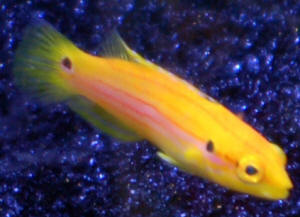 |
|
Help with Hogfish ID 2/10/09 Hi WWM Crew,
<Tom> I have this "Peppermint Hog" on hold at the
LFS, and am trying to figure out exactly what it is. <Bodianus
masudai> I've been Googling and it looks mostly like B.
masudai or B. opercularis to me, but could you give a look and
see if you can tell from this photo? There is a third white
stripe, lower on the side, that's not real visible in the
photo. What is the difference between these similar species?
<Mmm, the boldness, darkness of the red stripes... and smaller
white ones... of the latter for me.> In researching this fish
I'm also looking for compatibility issues. We have a small
group of four Bartlett's Anthias in a 135G reef setup, do you
see any potential issues with this hogfish? Thanks, <Likely
will get along. Welcome. Bob Fenner>
|
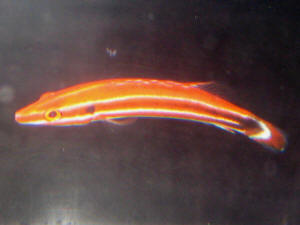 |
|
Re: Help with Hogfish ID 2/11/09 Hi Bob,
I'm thankful for your advice. <Am grateful to render my
opinion> I'm seeing info on WWM and Fishbase that
describes the B. masudai as a subtropical species, so maybe
it's not such a good fit for our tropical (81-82F) reef tank
- is this your opinion also? Thanks, Tom <I think you are fine
here. Have seen this Labrid kept in tropical circumstances
successfully. BobF>
|
|
What type of Wrasse is this? 10/11/08 Hi
there, Fantastic site. <Thank you.> I recently bought a
Wrasse which was incorrectly labeled in the store as a Leopard
Wrasse. <Indeed.> I can't, for the life of me, find
what type of Wrasse I have bought, even after sifting through
what seems like 100's of wrasse images on the Internet. Any
help would be appreciated. (image attached) Knowing will
obviously help me ensure any future purchases are compatible with
this little gem! Cheers Theo--- <It does appear to be a
Bodianus bimaculatus, Twinspot or Yellow Hogfish, a beautiful
fish! Visit
http://www.fishbase.org/Summary/SpeciesSummary.php?id=5499 for
more info. Scott V.>
|
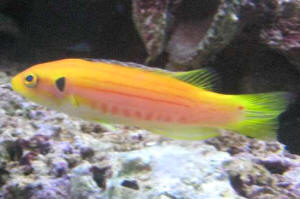 |
Hogfish I.D. (Bodianus perdito) 3/14/07 Hi
Crew! <Hi! How are ya?> I have recently acquired this
beautiful yellow hogfish. <I see it.> <<Graham...
where's the graphic? Need to move the original into the
"With Pix" folder... RMF>> After reading through
your facts and consulting fishbase, I am still at a loss to
identify the him. He is currently living in my 950L tank. Any
thoughts would be appreciated. The local fish store just labeled
him 'rare hogfish'. <Sigh...> That was the best they
had to offer. At least they could have tried and called him a
'purple spot hogfish' or something like that ;) <At
least they called him a hogfish at all. I prefer mysterious (not
mystery) wrasses to mislabeled. Seriously though, I'm 95% sure
that this is a Bodianus perdito, or the "Golden-Spot
Hogfish". Wrasses do go through very many changes through
their live-cycles, but I'm still pretty sure on this one. One a
side note, this "little" guy is capable of almost three
feet and will outgrow your system in a few short years. I would
think this guy would be bored and crowded in anything less than
3000L. Hope you can plan for that. -GrahamT>
Terri |
Re: Hogfish I.D. (Bodianus perdito) pt.2
3/14/07 Graham <Terri, thank you for the follow-up. I even
have a Q for you!> Thank you for your reply. I do understand
your concern that this critter gets an appropriate sized home. I
myself bang my head against a wall daily explaining to people that
seahorses cannot be kept in tiny aquariums just because they move
slowly. My smallest seahorse tank is 75 gallons! My 950L reef will
evolve into another seahorse tank when I move next month and the
new aquarium, (or 'swimming pool' in my husbands opinion),
is delivered. Just thought I would alleviate your concerns ;)
<Can you resend that graphic of the B. perdito? I forgot to
place it appropriately for placement on our website, and now
it's lost.> Terri
<-GrahamT> |
|
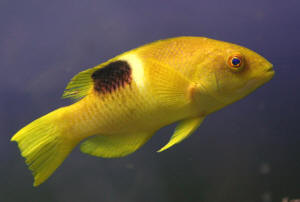
|
Yellow Candy Hog, Bimaculatus same fish?
9/4/06 Hello Bob. <James> Another wrasse question: Are the
Twospot, Bodianus bimaculatus and Yellow Candy Hog the same fish?
<Yep> I saw one at a LFS and am curious since the one they had
was yellow with two black spots (tail and I believe dorsal... but
memory fading with looking at so many pictures) and subdued pinkish
striping running laterally. It was about 2.5 to 3 inches and I presume
juvenile unless these are different fish. <Is likely: http://fishbase.sinica.edu.tw/Photos/ThumbnailsSummary.php?ID=5499>
I have been spending some time on fish base and did a google search and
have pictures of both with the same name and others site have a yellow
version only. <Oh!> I imagine the yellow is the younger version
though there is no picture of yellow version on fishbase.com. <Not
yet... maybe you'll send this in...> More important is
temperament for my tanks. Can this little beauty go into my main tank
with a Foxface (S. vulpinus), 2 cleaner shrimp, Flame Angel,
Checkerboard Christmas Wrasse (or ornate wrasse), firefish and royal
gramma? In there are also, various sponges, tunicates, mushroom,
frogspawn colonies and other lovely unknowns growing from the rock.
<Likely so...> I would be inclined to set up another tank (as I
like this fish enough to do so) if need be. I recall a one wrasse to a
tank rule of thumb. Much thanks. James Zimmer <Individual variation
may fine the existing Xmas Wrasse the problem... Bob
Fenner>
| Re: fish identifications Dear Robert: I am
a marine hobbyist for a few years. Recently I have seen a fish
picture from a Japanese website but can not identify the fish. Do
you know the scientific name of this fish? Does it have a common
name? Please reply to my e-mail. Regards, <The first fish is a
"Yellow Anthias", Odontanthias fuscipinnis (Jenkins
1901), info. placed here:
http://www.wetwebmedia.com/anthiinFAQs.htm the second is a Bodianus
bimaculatus Allen 1973, the Twinspot or Yellow Hogfish which you
can read about on the coverage of the genus on WetWebMedia.com as
well. Bob Fenner> Jeff |
IDENTIFICATION OF WRASSE I am having a very
difficult time identifying the fish shown in the attached photos. I
believe it is a wrasse and would like to further identify it and
further research it. Any input you can provide would be greatly
appreciated. <It's a washed-out Bodianus bimaculatus. See
here: http://www.wetwebmedia.com/bodianus.htm Bob Fenner>
Thanks in Regards,
Jim |
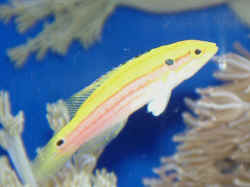
|
RE: IDENTIFICATION OF WRASSE Thanks for your quick
response. I might be a little washed out due to my photographic skills.
I appreciate your help. <Could just be the specimen. Bob Fenner, who
is for sure washed-out from micro-brews and hot wings night last>
Regards, Jim
Species ID, info (Bodianus spp.) Recently purchased a
fish that is virtually indiscernible from the fish pictured on your
site that you call a "Blackspot Hogfish" (Bodianus
opercularis). The wholesaler's invoice, however, identified it as
B. masudai. This is also the name given on the Marine Center website,
about the only e-tailer that ever offers it for sale. <I see:
http://www.themarinecenter.com/bodianusopercularis.htm
This is what I believe to be B. opercularis...> I looked on the
fishbase.org site and my fish bears much greater resemblance to their
photos of opercularis, so I am inclined to think the wholesalers (and
the Marine Center) are wrong, <Me too. Fishbase:
http://www.fishbase.org/Summary/SpeciesSummary.cfm?ID=23526&genusname=Bodianus&speciesname=masudai
(for B. masudai) and
http://www.fishbase.org/Summary/SpeciesSummary.cfm?ID=25754&genusname=Bodianus&speciesname=opercularis
(for B. opercularis)> especially since the invoice that accompanied
my fish stated that it came from Oceania-- not exactly specific, but B.
masduai is only found in Japan according to fishbase.org, while B.
opercularis would logically be found in Oceania. <This is correct.
B. opercularis occurs from the Red Sea, in various places of tropical
Indian Ocean over to Christmas Island... its range with B. masudai is
distinct, does not overlap> This is an important question for two
reasons-- first, B. masudai must be sub-tropical if it only comes from
Japan, and therefore, I assume, will perish in my 80 degree tank.
<Mmm, IS subtropical... according to Fishbase as well as logic
(location)... would try to keep temperature below 80 F> On the other
hand, masudai only attains a size of 12 cm, whereas you list
opercularis at a more gargantuan 9 inches (Fishbase claims 18cm max--
any idea why your figure is higher?). <Thanks for this... can't
discern from my paltry notes on WWM (but/and am soon to be "on
to" the labrids (am on the labroids which are... now,... the
damsels)... for NMA v.2...)... can't recall or reason where I would
have come up with the nine inch maximum... About the biggest I've
seen (Red Sea) are six inches, and those in captivity even smaller. I
suspect the 18 cm., about seven inch maximum (or a fudge mark for
"real" standard length) is closer to reality> In my case,
"size matters" as well, since I've got it in a 90 gallon
reef, where it is, by all behavioral measures, a perfect fish at this
point. Any chance your 9 inch claim is (as they tend to be) an
exaggeration? 18 cm or less is much more to my liking. <Ha! I
suspect your fish will be fine, will "max. out" at a handful
(not two!) of inches> Thanks again, Derek Milne <Thank you for
writing. Let's go diving this next year (after Interzoo in May...
in the Red Sea) and measure them ourselves! Bob Fenner>
|
|

